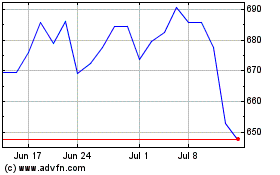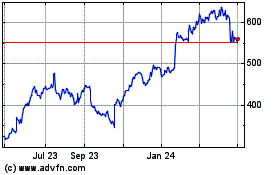After spending nearly $50 billion in the summer of 2015 to
acquire DirecTV, AT&T Inc. is preparing to roll out an internet
video service that could upend its satellite-television business
along with the rest of the pay-TV industry.
The service, called DirecTV Now and expected to launch by
year-end, will stream dozens of live channels to televisions and
mobile devices without the need for a satellite dish, cable box or
annual contract. Unlike Netflix or Hulu, this over-the-top service
is intended to provide a full cablelike lineup for households.
AT&T executives aren't concerned that a lower-priced
internet video service—observers expect around $50 a month—could
eat into its existing TV business, which had 25.3 million
subscribers who paid an average monthly bill of $117 in the latest
quarter. "That means you have found something that the market
really, really wants," Chief Executive Randall Stephenson said last
month, at an investor conference.
DirecTV Now will enter a promising but increasingly crowded
marketplace with customers paying as little as $20 a month to
stream almost 30 channels from Dish Network Corp.'s Sling TV
service to as much as $75 a month for a bundle of more than 100
channels, including HBO and Showtime, from Sony Corp.'s PlayStation
Vue service.
AT&T says it is going after 20 million U.S. households that
don't pay for home TV, including cord-cutters and younger
customers. But the telecom giant isn't planning a so-called skinny
bundle. It boasts of having more than 100 channels signed up for
DirecTV Now, including ESPN, Discovery Channel and Nickelodeon.
"We think skinny bundles have very small application in the
market over time," said John Stankey, head of AT&T's
entertainment business, at an industry conference earlier this
year. People in a household are going to want to watch different
things, he said. "There's a reason to look at a much broader
offering of content."
The big bundle strategy opposes moves from channels that have
tried reaching viewers on their own, like CBS Corp. and Time Warner
Inc.'s HBO.
It is also an attempt to get ahead of others reportedly lining
up wider cablelike services, including Apple Inc., Amazon.com Inc.,
Alphabet Inc. and Hulu, which is owned by Comcast Corp., Time
Warner, Walt Disney Co. and 21st Century Fox Inc. (21st Century Fox
and News Corp, which owns The Wall Street Journal, share common
ownership.)
Mr. Stephenson said DirecTV Now would have a "very, very
aggressive price." The company hasn't disclosed details. UBS
analysts project the monthly price at $50 while Barclays estimates
$50 to $60. The number of streams people can view at the same time
will be limited to two, according to a person familiar with the
company's plans.
"It will be the first indication for the public demand of this
type of product," said UBS analyst John Hodulik, referring to a
cable-replacement product from a major pay-TV service. "This is the
first big launch."
UBS projects that AT&T will have 2.5 million subscribers for
the service by 2020. Mr. Hodulik expects a short-term hit to
margins as the company spends to set up and market the product.
Mr. Stephenson says the profits on the new service will be
"thinner than what we are accustomed to" but stressed the product
won't require a lot of capital investment. Compared with the
traditional satellite service, DirecTV Now won't require hardware
or visits by technicians. Sign-up and billing will be done
online.
AT&T's content chief Dan York, who held the same role at
DirecTV before the deal, has spent the past year renegotiating with
content providers to get the necessary rights. AT&T still has
deals to close, including with CBS and 21st Century Fox.
AT&T has put together other pieces it needs; In June, it
bought Quickplay Media, which built the platform for the service.
AT&T also has a joint venture with media mogul Peter Chernin
called Otter Media that focuses on producing online video.
The company plans to bundle DirecTV Now with its home broadband
service and wireless plans, which could help reduce customer churn.
Wireless data used to watch DirecTV Now on smartphones or tablets
will be free for AT&T's more than 77 million mainstream
wireless subscribers.
The cable companies aren't sitting still. Both Comcast Corp. and
Charter Communications Inc.—the largest U.S. broadband
providers—recently said they plan to begin selling wireless phone
service to their customers.
Comcast CEO Brian Roberts, however, has signaled he isn't
planning to follow AT&T's lead, saying the economics are
unproven for over-the-top services. "Out of footprint, it's not
clear that that's the right strategy for us," he said in July.
Meanwhile, AT&T is under pressure to deliver gains from the
DirecTV deal, which boosted video revenue to about a fifth of its
total business. While AT&T has added satellite users, it has
lost almost 200,000 pay-TV subscribers overall since closing the
deal.
"They are going to where the people are and that is increasingly
[over-the-top] and mobile," said Peter Csathy, chairman of
CreatvMedia, an advisory firm. "It is a smart strategy."
Ryan Knutson and Shalini Ramachandran contributed to this
article.
Write to Thomas Gryta at thomas.gryta@wsj.com
(END) Dow Jones Newswires
October 19, 2016 17:25 ET (21:25 GMT)
Copyright (c) 2016 Dow Jones & Company, Inc.
Netflix (NASDAQ:NFLX)
Historical Stock Chart
From Mar 2024 to Apr 2024

Netflix (NASDAQ:NFLX)
Historical Stock Chart
From Apr 2023 to Apr 2024
